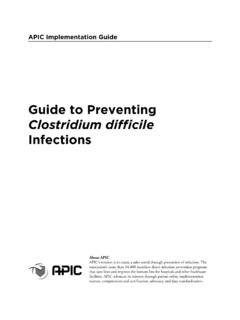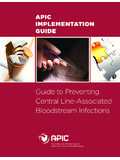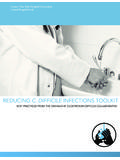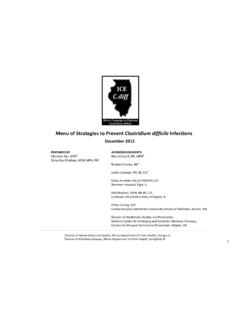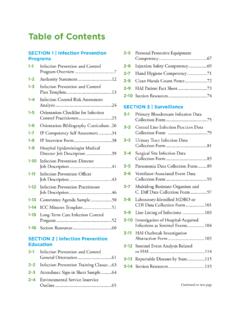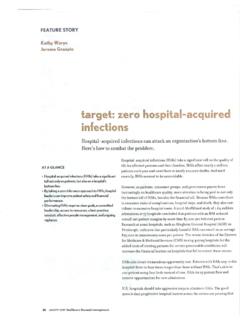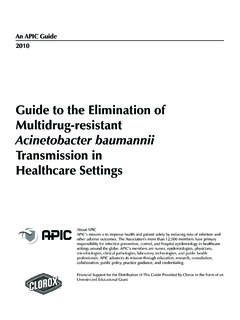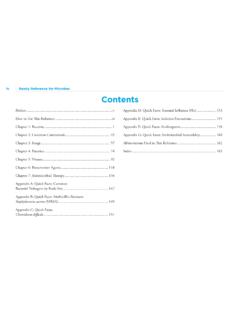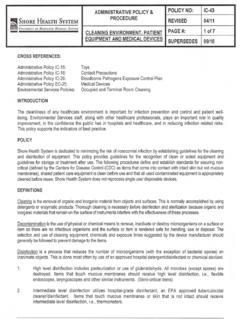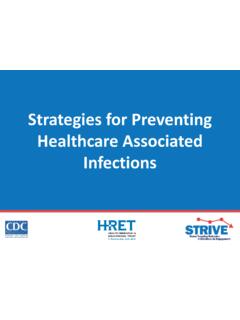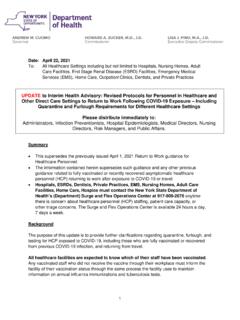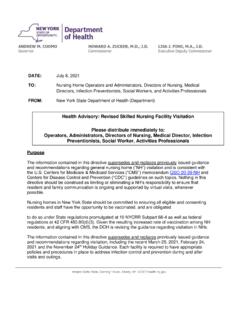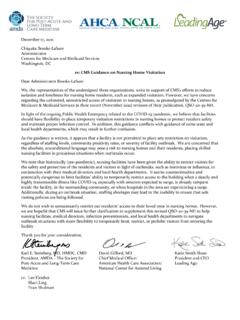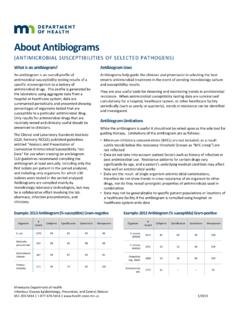Transcription of Infectious Disease Disasters: Bioterrorism, Emerging ...
1 Chapter 120. Infectious Disease Disasters: bioterrorism , Emerging infections , and Pandemics Terri Rebmann, PhD, RN, CIC o The feasibility of these agents, if delivered from a line Associate Professor source ( , an airplane) upwind from the target, to infect Saint Louis University, School of Public Health Institute for large numbers of the population Biosecurity St. Louis, MO o The ability to spread infection, Disease , panic, and fear. Infectious diseases continuously emerge and/or reemerge, resulting in epidemics of varying sizes and scope. ABSTRACT Pandemics pose the biggest potential threat to the public's health in terms of morbidity and mortality, and there is a high Infectious Disease disasters are events that involve a biolog- likelihood of a pandemic occurring in the future.
2 Ical agent/ Disease and that result in mass casualties, such as a bioterrorism attack, a pandemic, or an outbreak of an infection preventionists must undertake preparedness ac- Emerging Infectious Disease . Infectious Disease disasters tivities to ensure that they and their healthcare facilities and are different from other types of disasters because they communities are better prepared to effectively recognize and increase the risk of communicable Disease spread during and respond to an Infectious Disease disaster . after the incident. Subsequently, they involve the need for Infectious Disease disaster preparedness is an ever-evolving specialized mitigation, planning, and response interventions process that addresses the four principles of emergency to prevent and control the spread of Disease .
3 As experts management: mitigation, preparedness, response, and in the fields of surveillance, epidemiology, and prevention recovery. of communicable Disease spread, infection preventionists play a critical role in emergency management of Infectious Disease disasters at the personal, hospital/healthcare facility, and community level. Emergency management of Infectious BACKGROUND. Disease disasters is a multidepartmental and multi agency Definitions of bioterrorism , Emerging infections , endeavor that encompasses the four principles of emergency and Pandemics management: mitigation, preparedness, response, and bioterrorism (also known as biological terrorism) is the inten- tional use of a biological agent or derivative of such an agent to inflict harm or death onto a civilian population.
4 Biological KEY CONCEPTS warfare differs from bioterrorism in that the target of the attack is military personnel. For the purposes of this chapter, the Infectious Disease disasters consist of biological terrorism, term bioterrorism will encompass both attacks on military and Emerging Infectious Disease outbreaks, and pandemics. civilians using a biological agent/weapon. Infectious Disease disasters pose unique challenges to infec- Emerging infections are those that are new to a population or tion preventionists and disaster planners. geographical region, or have increased rapidly. Many emerg- There are a broad range of potential bioterrorism agents, ing infections , such as methicillin-resistant Staphylococcus including bacteria, viruses, and toxins (of microbial, plant, or aureus (MRSA) and human immunodeficiency virus (HIV), animal origin).
5 Common characteristics of this diverse group routinely occur throughout the world and are not covered in of agents include: this chapter. Information on MRSA and HIV can be found in Chapters 26 Antimicrobials and Resistance, and 81 HIV/AIDS. o The ability to be dispersed in aerosols of 1 to 5 micron- Only newly Emerging ( infections that are new in humans) or sized particles, which can penetrate the distal bronchioles reemerging infections ( infections that occurred in the past but o The ability to deliver these aerosols with simple technology are now increasing in number or changing geographical area). Infectious Disease Disasters: bioterrorism , Emerging infections , and Pandemics 120-1. are addressed in this chapter. For the purposes of this chapter, many others.
6 Many factors affect the emergence of Infectious the term Emerging infection is used in lieu of the terms newly diseases, including social (war, human migration, and urbaniza- Emerging and reemerging infections . tion), microbial (genetic mutation, recombination, and assort- ment), and environmental (earthquakes, floods, deforestation, Pandemics are global outbreaks of Disease in humans that changes in animal/insect populations) ,8. exceed expected rates or morbidity and mortality. The impact of Emerging infections depends on the agent Historical Perspective of Infectious Disease involved and the size of the event. For example, the 2012. Disasters and Future Potential Impact multi-state outbreak of Escherichia coli 0145 was a relatively small event; 18 individuals were infected, with only a single bioterrorism In contrast, the 2009 H1N1 influenza A virus devel- The use of biological agents on populations to cause harm or oped into a pandemic, resulting in ~575,000 The death is not a new concept; countries have been conducting future potential impact of Emerging infections is unknown, but bioterrorism for hundreds of years.
7 bioterrorism dates back to it is expected that Infectious diseases will continue to emerge or the 14th century, when cadavers were dropped into enemy reemerge, resulting in epidemics of varying sizes and scope. wells to poison the drinking Another example of bioter- rorism occurred during the French and Indian War, when Native Pandemics Americans were given smallpox-laden blankets. This action is Of all types of Infectious Disease disasters, pandemics pose believed to have initiated smallpox in this previously unexposed the biggest potential threat to the public's health in terms of population and resulted in a 40 percent mortality rate. More morbidity and mortality. Historically, influenza pandemics occur recent examples of bioterrorism include the intentional contam- on a semiregular basis.
8 During the 20th century, three influenza ination of salad bars in The Dalles, Oregon, using Salmonella2. pandemics (in 1918/1919, 1957/1958, and 1968/1969). and the 2001 attack using anthrax-laden letters mailed to media resulted in more than 779,000 deaths in the United States organizations and politicians. and approximately 53 million deaths In 2009, a new strain of influenza A (H1N1) emerged and quickly became bioterrorism has the potential to result in high morbidity and a pandemic, resulting in 151,700 to 575,400 deaths world- mortality, because aerosolized biological agents can infect or In addition, there have been several incidents in the kill many people in a short period of time. Even nonaerosolized last 40 years in which an influenza strain had the potential of attacks, such as the anthrax bioterrorism attack in the United causing a pandemic, including scares or pandemic threats.
9 States in fall 2001, can result in morbidity, mortality, and the with swine, Russian, and avian need to formulate a significant healthcare, public health, and emergency management response. It is not known when or if The potential impact of a future pandemic is staggering. It has another bioterrorism attack will occur. However, bioterrorism been estimated that an influenza pandemic could infect approx- preparedness helps mitigate potential negative outcomes, and imately 30 percent of citizens (~90 million individuals), is required by healthcare and public health regulating agencies require the need for 45 million additional outpatient visits to as part of a comprehensive emergency management healthcare agencies and 865,000 to 9,900,000 hospitaliza- The future potential impact of bioterrorism depends on the tions, result in 89,000 to 207,000 deaths, and cost between agent used, the amount disseminated, the dispersal method, $71 and $166 billion in the United States 14.
10 The weather/release conditions, the preexisting immunity of the exposed population, and how quickly the attack is identi- As experts in the fields of communicable diseases, infection fied. The 2001 bioterrorism attack caused 22 cases of anthrax prevention, and epidemiology, infection preventionists (IPs). and five deaths, required over 10,000 doses of postexposure are poised to be at the forefront during an Infectious Disease prophylaxis to be distributed, and cost more than $ billion, disaster . As such, IPs must embrace their role as experts in yet was, essentially, a small event involving only the use of 2. Infectious Disease emergency management and assist their to 3 ounces of anthrax ,5 Researchers estimating the healthcare facility or community in becoming better prepared to potential morbidity, mortality, and cost associated with a bioter- rapidly, appropriately, and effectively respond to an Infectious rorism attack indicate that an aerosolized release of Francisella Disease disaster .
